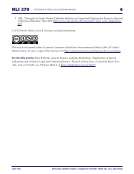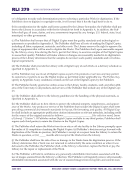June 2012 Research Library Issues: A QuarterlLy Report from ARL, CNI, and SPARC
RLI 279 21
Copyright Risk Management
cases, where the rights holders were careful not to deny permission but only to refuse to grant it, the
library recognized that its fair-use argument still provided enough security to proceed. In almost two
years, this project, which seemed very risky on first evaluation, has generated no complaints (and thus no
need to use the take-down policy associated with it) while proving very popular with researchers and the
general public. In the other case, a joint venture between four libraries, the importance of the strategies
was more administrative it allowed the libraries involved to convince all of the four provosts of their
universities to endorse the project, which was an important step toward obtaining grant funding.
Orphan Works
It is an interesting exercise to consider how orphan works—works that are putatively still protected by
copyright but for which no rights holder can be located or successfully contacted—fit into the strategies
that have been outlined above.
Orphan works are, by definition, not part of the public domain. But the first strategy, that of
recognizing the scope of the public domain relative to a proposed digitization project, may have the effect
of helping the librarians planning the project understand that the orphan works problem is smaller than
they feared. As Wilkin points out in his article on bibliographic indeterminacy, we often lack enough
information to decide, for example, whether a work did have its copyright renewed, so that it is potentially
an orphan, or whether it did not and is therefore in the public domain.11 So analysis of a collection in
regard to the likelihood of public-domain materials would also help reduce anxiety over the size of the
orphan work problem.
Permission is impossible for orphan works, again by definition. But we should recall that the reason
for seeking permission from major or potentially litigious rights holders is to reduce the number of likely
plaintiffs a library might provoke. Because rights holders in orphan works cannot be located, and in many
cases probably do not even know that they hold rights (as is probably the case, for example, with the heirs
of a letter writer), they should not be counted in the pool of potential plaintiffs. Also, if a rights holder for
a work previously considered an orphan does surface, a take-down policy and the willingness of the
library to discuss the matter will be especially likely to defuse the problem, since the rights holder would
have little expectation of profit from the work.
Fair use, of course, applies equally to orphan works as it does
to in-copyright works for which the rights holders are known or
discoverable. Indeed, fair use is probably itself the best “solution” to the
orphan works problem, at least in the context of large-scale digitization
of library collections. In addition to the support for a fair-use argument
that has already been discussed, the fact that a rights holder has not
been discoverable or willing to respond to a permission request further
strengthens the fourth-factor argument that the use in question does
not harm the market or potential value of the work. By definition, again,
orphan works are not subject to normal commercial exploitation or to regular licensing, so the fair-use
defense becomes quite strong.
The fair-use defense for digitizing large special collections is not, of course, entirely uncontroversial,
as is shown by the recent litigation brought against HathiTrust and five of its university partners by the
...fair use is probably itself
the best “solution” to the
orphan works problem, at
least in the context of large-
scale digitization of library
collections.
RLI 279 21
Copyright Risk Management
cases, where the rights holders were careful not to deny permission but only to refuse to grant it, the
library recognized that its fair-use argument still provided enough security to proceed. In almost two
years, this project, which seemed very risky on first evaluation, has generated no complaints (and thus no
need to use the take-down policy associated with it) while proving very popular with researchers and the
general public. In the other case, a joint venture between four libraries, the importance of the strategies
was more administrative it allowed the libraries involved to convince all of the four provosts of their
universities to endorse the project, which was an important step toward obtaining grant funding.
Orphan Works
It is an interesting exercise to consider how orphan works—works that are putatively still protected by
copyright but for which no rights holder can be located or successfully contacted—fit into the strategies
that have been outlined above.
Orphan works are, by definition, not part of the public domain. But the first strategy, that of
recognizing the scope of the public domain relative to a proposed digitization project, may have the effect
of helping the librarians planning the project understand that the orphan works problem is smaller than
they feared. As Wilkin points out in his article on bibliographic indeterminacy, we often lack enough
information to decide, for example, whether a work did have its copyright renewed, so that it is potentially
an orphan, or whether it did not and is therefore in the public domain.11 So analysis of a collection in
regard to the likelihood of public-domain materials would also help reduce anxiety over the size of the
orphan work problem.
Permission is impossible for orphan works, again by definition. But we should recall that the reason
for seeking permission from major or potentially litigious rights holders is to reduce the number of likely
plaintiffs a library might provoke. Because rights holders in orphan works cannot be located, and in many
cases probably do not even know that they hold rights (as is probably the case, for example, with the heirs
of a letter writer), they should not be counted in the pool of potential plaintiffs. Also, if a rights holder for
a work previously considered an orphan does surface, a take-down policy and the willingness of the
library to discuss the matter will be especially likely to defuse the problem, since the rights holder would
have little expectation of profit from the work.
Fair use, of course, applies equally to orphan works as it does
to in-copyright works for which the rights holders are known or
discoverable. Indeed, fair use is probably itself the best “solution” to the
orphan works problem, at least in the context of large-scale digitization
of library collections. In addition to the support for a fair-use argument
that has already been discussed, the fact that a rights holder has not
been discoverable or willing to respond to a permission request further
strengthens the fourth-factor argument that the use in question does
not harm the market or potential value of the work. By definition, again,
orphan works are not subject to normal commercial exploitation or to regular licensing, so the fair-use
defense becomes quite strong.
The fair-use defense for digitizing large special collections is not, of course, entirely uncontroversial,
as is shown by the recent litigation brought against HathiTrust and five of its university partners by the
...fair use is probably itself
the best “solution” to the
orphan works problem, at
least in the context of large-
scale digitization of library
collections.
























